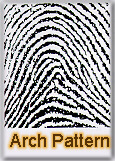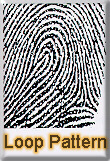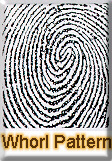



| Finger prints -- basic information |
| You must have heard
about this quite a lot of times--there can't be 2
fingerprints alike for 2 different individuals and is unique for every individual in earth and ones who is yet to be born. Is it true? YES!!. Such is the creation of God. Let's see what finger prints mean and how is it used in forensic science to apprehend the criminals. Ofcourse this technology is one the method to identify an individual apart from DNA printing, hair and other evidences. |
| There are three basic fingerprint patterns: Loops, Arches and Whorls. Everyone falls into one of these three patterns (diagram). Within these patterns are what we call minutae points. There are about thirty different types of minutae points, and no two people have the same types of minutae in the same number in the same places on their fingertips. This is why our fingerprints are totally unique. |
   |
 |
|
Your fingerprint patterns are hereditary. They are formed before
you are born, while you are still in the womb, they never change through
out your lifetime, and they are even around for awhile after you die.
So, why are fingerprints so good for identification purposes? They
are totally unique, and they never change.
Your fingerprints are formed underneath your skin in a layer called dermal papilae. As long as that layer of papilae is there, your fingerprints will always come back, even after scarring or burning. Gloves don't necessarily help you from leaving fingerprints. Surgical gloves were made to keep surgeons from infecting their patients. You can actually leave prints through surgical gloves. Surgical gloves were made to keep sterile conditions during operations. They have to fit like a second skin for surgeons to be able to pick up their instruments. They fit so tightly that fingerprints 'pass through' the latex membrane. They can also be turned inside out to yield fingerprints from the inside surfaces. Leather gloves can be treated in the same manner. Also, leather gloves can leave a print that is unique to that glove and no other (leather comes from cow skin, which is just as random as human skin). Even cloth gloves, such as mittens, can leave a distinctive print that can be traced back to the mitten that made it. Prints are left on a surface because we are constantly secreting water and body oils and other compounds through our pores. This material is left on the surface we touch in the form of a fingerprint. Different surfaces require different techniques for developing prints. In the movies, you usually see detectives with brushes. They are powder processing the prints. Minute particles of powder cling to the print residue as the brush passes over it. The print is then lifted with tape. Another process involves fuming. Vapors of iodine and superglue (bonds in seconds) will coalesce inside the print residue to reveal a latent print. There are special processes that develop prints on paper, wood and cardboard. Fingerprints can be developed on objects that have been in water. Prints can be developed off of skin (such as from the neck of a strangulation victim). There are very few surfaces on which a print cannot be developed. Computers have revolutionized the techniques used to match fingerprints. Until recently, the old standard was the Henry Classification System; a cumbersome sequence of letters and numbers broken down into several levels of classification. It could take weeks, sometimes months to compare a suspect fingerprint to a department's print files. The advent of digital technology has changed all of that. Prints can be image scanned directly into a computer, doing away with ink and fingerprint cards. Prints can be compared at a rate of 400,000 per second. You couldn't do that in your lifetime.
It's called AFIS. Automated Fingerprint Identification System.
Departments will input all the prints from arrests and all of the print
cards they already have on file to create an historical record. They
also input all of the prints from any unsolved crimes, in the hope that
a hit might come up from a routine arrest. Local departments are
linking their systems into a national database. The FBI wants national
standards and a fully functional national network in place by the year
2000. With a national network, you could get busted in New York and
have a print hit come up from a crime you committed in California.
Q. What is a latent print?
Q. What is an inked fingerprint?
I think I will stop with this....I can
go on and on forever on this subject.
|